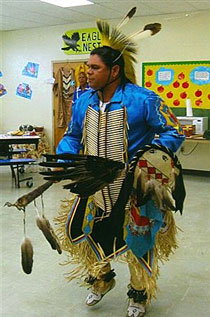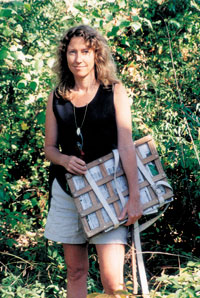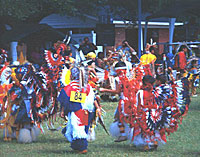UAB Team Tracks a Forgotten People
By Claire L. Burgess
 |
After years of isolation and poverty, Alabama’s MOWA Choctaw tribe is reclaiming its roots—with the help of UAB alumna Jacqueline Matte and UAB anthropologist Loretta Cormier. |
Thirty years ago, UAB alumna Jacqueline Matte went out to the Choctaw reservation in southwest Alabama in search of a story. What she found has haunted her ever since, fueling decades of interviews, investigations, and heartache. Nine years ago, UAB anthropologist Loretta Cormier, Ph.D., joined the struggle. Separately and together, Matte and Cormier have fought through swamps both literal and legal, seeking clues to one of the great vanishing acts in Alabama history. It is no easy task; after all, they are looking for a people who haven’t wanted to be found for more than 150 years.
The Alabama Choctaw lived in poverty and isolation until the 1940s, when they began sending some of their children to Indian schools in other states because their own were not accredited. When those educated children came home, they led the tribe out of isolation and into the public eye, launching a campaign for state recognition. In 1979, they officially became the MOWA Band of Choctaw Indians, the first recognized tribe in Alabama. (The name MOWA comes from the tribe's location on the Mobile County-Washington County line.) The following year, the tribe began to seek federal recognition, a lengthy and involved process requiring extensive genealogical research. That is where Jacqueline Matte comes in.
 |
Jacqueline Matte first contacted the MOWA Choctaw in 1980 while she was researching her first book. She now holds the title of Tribal Historian. |
Evidence of Existence
Matte, who holds master’s degrees in history and education from UAB, has been working with the MOWA since 1980, when she approached them while conducting research for her first book, A History of Washington County: The First County in Alabama. “I wanted to include all races, so I included the Indians,” says Matte, “and they said that was the first time anyone had ever asked them who they were. People would write about them, what white folks or black folks said about them, but not what they said themselves.”
From that point on, Matte began making regular trips to the reservation to help in the bid for federal recognition; she eventually compiled her research into several articles and a book, They Say the Wind is Red. Matte now holds the title of Tribal Historian and continues to volunteer her time to continue the research.
Cormier, the MOWA’s Tribal Anthropologist, got involved around 2000, when she came to teach at UAB. “I wanted to know something about local Indians in the area, so I went to the library and saw Jackie’s book,” says Cormier. “I gave her a call, and we met and just clicked. She put me to work immediately.” Cormier first went to the reservation to continue her research in ethnobotany, specifically the traditional uses of medicinal plants, but soon got involved with the petition for federal recognition. “They told me, ‘we don’t have a nickname for you yet,’ because they had horrible nicknames for other anthropologists who came down,” she says. “So I took that as meaning I was okay.”
No People on Paper
 |
The MOWA Choctaw: A HistoryThe Choctaw have lived in modern-day Mississippi and Alabama far longer than documented history can tell. One of their origin myths tells of how the nation traveled for many years from a place far in the west, past the river and the mountains and the snow, carrying the bones of their ancestors on their backs and led by a medicine man with a red pole. Read more. |
Despite being recognized by the Senate Select Committee on Indian Affairs in 1991, the MOWA found their petition denied by the Bureau of Indian Affairs (BIA) in 1997. The BIA cited a failure to prove Native American ancestry; it requires that petitioners be able to trace their lineage to the Indians of the early 19th century through documentary evidence—which, for a tribe that spent decades in hiding to avoid removal and persecution, is well nigh impossible.
“What they need is written government documents that say they’re Indian,” says Cormier. “But if you’re an Indian hiding out because you don’t want to get sent to Oklahoma, you’re not going to keep records like that. Also, the Indians didn’t have a written language, so they didn’t keep any written records. They have a rich oral tradition, but the BIA won’t accept that.”
The U.S. Census records provide no help. Before the Civil War, Indians who weren’t associated with a larger tribe were listed on census records as Free People of Color, a general label for anyone who was not white but also wasn’t a slave. After the Civil War, the census rules in Alabama and across the South dictated that anyone who was not “pure white” be classified as “negro,” including Indians, mixed races, and other races. And the rules changed every 10 years. “The same person one year would be classified as Indian, another year they’d be classified as black, or even white,” says Cormier. The Choctaw of southwestern Alabama were even referred to as “Cajuns” for decades, thanks to a local senator who mistakenly labeled them as such because he thought they resembled the Louisianans of Acadian descent.
Proof of Presence
 |
Loretta Cormier began working with the MOWA Choctaw soon after she came to UAB. |
Subsequent attempts to gain federal recognition, including a lawsuit against the BIA and two bills introduced to Congress, have all been denied, despite support by numerous federally recognized tribes, national Indian organizations, a large number of ethnologists, linguists, anthropologists, and university professors—and Matte’s research.
Included in Matte’s collection are numerous 19th and 20th-century photographs and negatives depicting ancestors of the MOWA, court documents and records, newspaper clippings, journals, manuscripts, correspondence, and around 200 hours of audio interviews. Many of these documents demonstrate the consistent presence of the MOWA’s ancestors in the area all the way back to Indian Removal, including land records; birth, marriage, and death certificates; written observations by scholars, scientists, and government officials; and correspondence between the Indians and the U.S. government.
“I’ve got all the letters from the National Archives for 30 years, from 1830 until the Civil War started,” Matte says. The Indians would find a literate white person whom they trusted and get them to write letters to the government or the president pleading for help. “‘We’re here; we’re landless; we’re being taken advantage of; we’re starving,’ they would say,” Matte explains, “and all the names would be spelled phonetically by the white person and marked with an ‘X’ by the Indians.” But the BIA has problems with these records, too. The Anglicization of names, inconsistency of spellings, and the use of marks instead of signatures makes these records problematic.
 |
The MOWA Choctaw Today:
|
Like many Native American tribes, the Alabama Choctaw passed on their histories in stories told from generation to generation. “The old folks, if you get them talking, they’ll go on for hours,” says Matte. “This one man, Daddy Richard, was 92 when we talked to him and could remember back to when he was 3 years old. He could tell you people’s names, their birthdays, who they married, their parents—all the way back. Their memories were their history books, their documented history.” However, the BIA does not accept oral histories as reliable evidence. And as Chief Wilford “Longhair” Taylor said in a 1996 letter to the BIA, “the strongest evidence of our American Indian ancestry is not found in written documents, it is found in our lives.”
“The irony is that throughout their history, they’ve been discriminated against and taken advantage of because they were Indian,” says Cormier. “And now that it could be a benefit to them to be Indian, to be federally recognized and maybe get some approved education and job opportunities—then they’re not Indian anymore.”